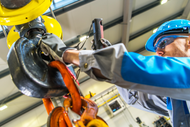Cranes and hoists are standard equipment in many commercial and industrial operations. Understanding and implementing crane and hoist safety is crucial to ensure a safe working environment and reduce damage to facilities and products through accident prevention. Here is a set of key points, i.e., Crane and Hoist Safety 101, to use from Protek Crane Solutions:
Identifying Safety Hazards
-
Overloading – This is the most common hazard. Employees unintentionally attach a load that exceeds the recommended weight limit, which can cause the crane or hoist to cease operation.
-
Load Imbalance – Multiple boxes or unwieldy items, such as an automobile axle, can shift during lifting and cause a crane or hoist to halt or even break.
-
Mechanical Failures – Its manufacturer’s warranty covers each crane and hoist Protek sells. However, failures can still happen due to an error during manufacturing or if dirt, grease, or other contaminants get into the gears or other parts of the equipment.
-
Electrical Hazards – While rare compared with other hazards, these can happen during power outages, circuit overloads, or (and more rare) a lightning strike that affects the facility’s electrical system.
Safety Prevention Measures
-
Training Schedule – Employees need training on the equipment they use. Our installation and maintenance teams demonstrate proper operation to your company trainer for every crane and hoist we sell.
-
Inspection Schedule – Depending on the crane or hoist involved, monthly, quarterly, and annual inspections are needed to meet state and federal requirements. Protek maintenance teams can schedule every inspection to meet those requirements without interfering with daily operations.
-
Safety Gear – At a minimum, non-slip work shoes and appropriate gloves are needed in every operation. Hard hats, steel-toed boots, and safety harnesses for operators on catwalks and other overhead locations are necessary for industrial operations.
Applicable Regulations and Standards – Know Them
-
OSHA Regulations – OSHA 1910.179 governs the federal safety requirements for employees working with cranes, hoists, and other lifting equipment.
-
Industry Standards – ANSI B30.2.0-1967 governs overhead and gantry crane operations. ASME B30 governs operational and safety requirements for cranes and hoists.
-
State Regulations – These vary from state to state, but ANSI and OSHA rules serve as guidelines to ensure worker safety.
These points are the basic requirements every business owner, facility manager, and supervisor needs to be familiar with and implement in their operations. To learn more about the safety standards for every crane and hoist we sell and service, visitProtek Crane Solutions today. For any questions, you can also call us at (855) 776-8354. To stay informed about new additions to our inventory, sales, or changes to industry standards, follow us onFacebook,Instagram,Pinterest, andX.


